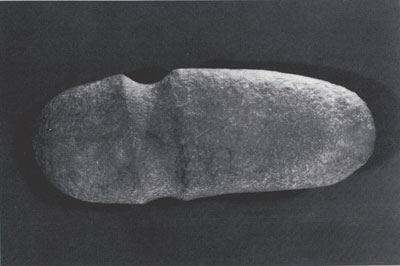
Grooved Stone axe, Museum Object Number: 1
At this, the centennial of the Museum’s building (see article by Douglas Haller, p. 31), we found ourselves wondering: What was that first object significant enough to be accessioned into the collections, and where in the world did it come from? We made a quick call to the Registrar’s Office—home of information on more than one million artifacts from around the world—only to find that accession number I, purchased in 1889, comes from New Jersey, right across the river!
Of course, nothing at a 110-year-old museum is ever that straightforward, and in fact, it’s impossible to be certain what our absolute “first” object is. In its earliest days, the Museum accessioned artifacts separately by section, as well as into the collections in toto. Thus, a Syrian vase bought by Mrs. I. C. Hilprecht and presented to the University of Pennsylvania a year earlier (in April 1888) “as the first object of the Babylonian [sic] Museum” has the number Bi—the “B” signifying an object in the Babylonian Section. This object is, unfortunately, now missing.
So we’re back to object 1, a large grooved stone axe from close to home. Such an axe might have been used by the Lenape Indians or their predecessors for felling trees, making canoes, or other woodworking tasks. And while it’s not particularly glamorous to look at, such stone tools testify to the long history of human occupation in the Delaware Valley, stretching back millennia before the Museum was a twinkle in anyone’s eye.
Pam Kosty
Assistant Director for Public Information
(Thanks to Dr. Richard Veit for the information on the axe and its collector.)
